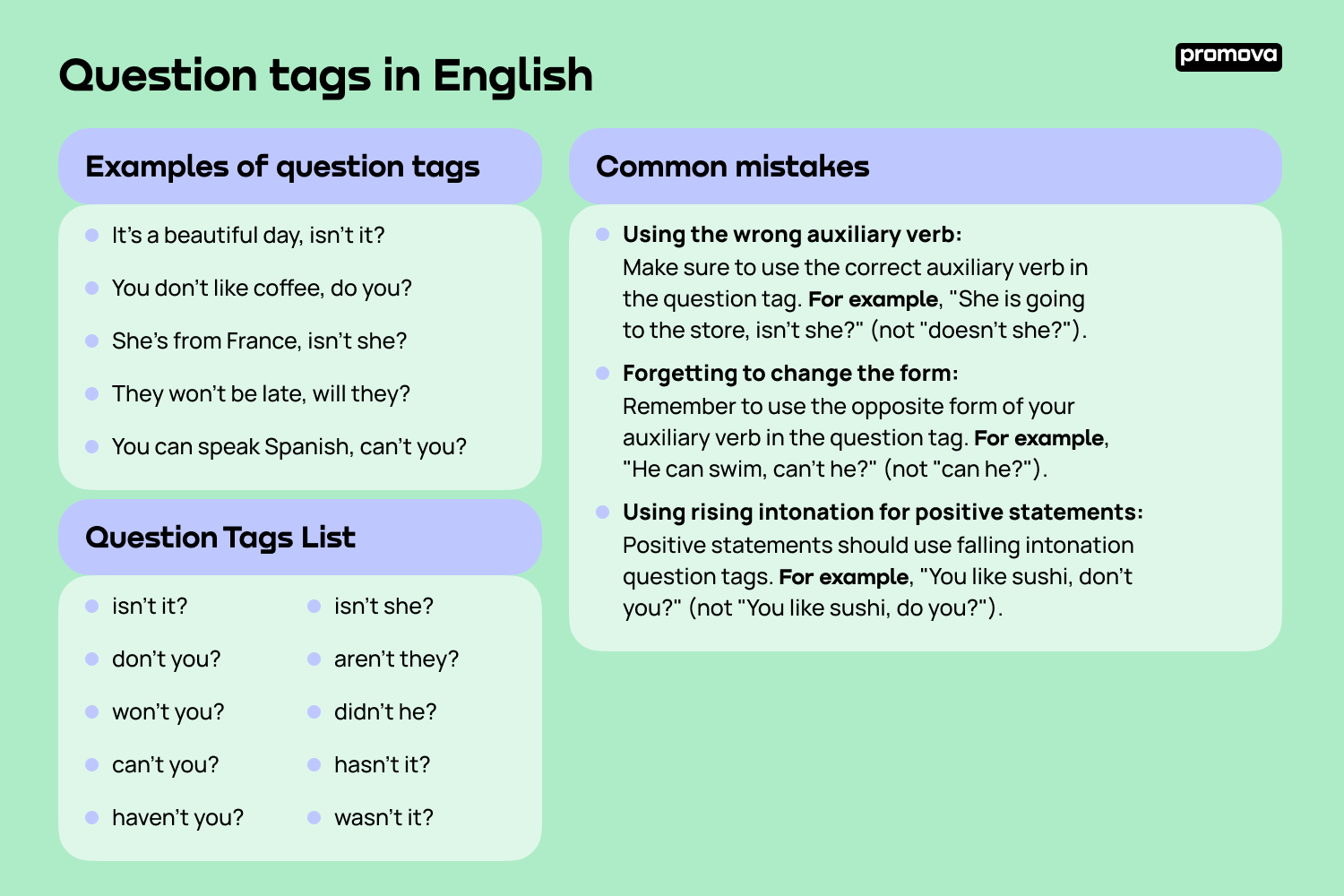Question tags in English
Contents
As you learn English, you will come across many different types of grammar rules and structures. One of these structures is the question tag, which is a small question added to the end of a sentence to check for confirmation or agreement. In this reference, we will cover the basics of question tags in English, including examples, how to form them, types of question tags, common mistakes, and when to use them in conversations. Let's get started!
What are question tags in English?
A question tag is a short question added at the end of a statement. It is used to confirm or check information, ask for agreement, or seek clarification. Question tags are common in everyday conversations and are often used to soften the tone of a statement or to show politeness. For example, instead of saying "You are coming to the party, right?" you can use a question tag at the end of the sentence like "You are coming to the party, aren't you?"
Examples of question tags
Here are some examples of question tags in English:
- It's a beautiful day, isn't it?
- You don't like coffee, do you?
- She's from France, isn't she?
- They won't be late, will they?
- You can speak Spanish, can't you?
As you can see from these examples, a question tag consists of an auxiliary verb and a pronoun, and is always in the opposite form to the statement. If your statement is positive, the question tag is negative, and vice versa.
How to form a question tag
To form a question tag, you need to follow these steps:
- Identify the auxiliary verb in the statement. This is usually a form of "be," "do," or "have."
- If the statement is positive, use a negative question tag. If the statement is negative, use a positive question tag.
- Use the opposite form of your auxiliary verb and add the pronoun at the end.
For example, if the statement is "You are going to the concert," the auxiliary verb is "are." To form a question tag, you would use the opposite form of "are," which is "aren't," and add the pronoun "you" at the end. The question tag would be "You are going to the concert, aren't you?"
Types of question tags
There are two main types of question tags: falling intonation and rising intonation.
- Falling intonation question tags are used when you are expecting agreement or confirmation. They have a falling tone at the end, which indicates that you are certain about the information. For example, "You like ice cream, don't you?"
- Rising intonation question tags are used when you are seeking information or clarification. They have a rising tone at the end, which indicates that you are unsure or seeking agreement. For example, "You didn't see the movie, did you?"
The difference between positive and negative question tags
As mentioned earlier, the form of the question tag depends on whether the statement is positive or negative. Positive statements use negative question tags, and negative statements use positive question tags.
- Positive question tags are used to seek agreement or confirmation. They are often used when you believe the statement is true and want the other person to confirm it. For example, "You like pizza, don't you?"
- Negative question tags are used to express doubt or seek clarification. They are often used when you believe the statement is false or want the other person to correct it. For example, "You haven't seen that movie, have you?"
Common mistakes
Here are some common mistakes that people make when using question tags:
- Using the wrong auxiliary verb: Make sure to use the correct auxiliary verb in the question tag. For example, "She is going to the store, isn't she?" (not "doesn't she?").
- Forgetting to change the form: Remember to use the opposite form of your auxiliary verb in the question tag. For example, "He can swim, can't he?" (not "can he?").
- Using rising intonation for positive statements: Positive statements should use falling intonation question tags. For example, "You like sushi, don't you?" (not "You like sushi, do you?").
3
When to use question tags in conversations
Question tags are used in everyday conversations to seek agreement or confirmation, express doubt, or seek clarification. They can be used in a variety of contexts, such as:
- Checking information: "The meeting is at 3 pm, isn't it?"
- Seeking agreement: "You like chocolate, don't you?"
- Expressing doubt: "You didn't eat all the cake, did you?"
- Showing politeness: "You'll save me a seat, won't you?"
Question tags can also be used to show empathy or sympathy, such as "You had a rough day, didn't you?" or "You're feeling better now, aren't you?"
A list of commonly used question tags
Here is a list of commonly used question tags in English:
- isn't it?
- don't you?
- won't you?
- can't you?
- haven't you?
- isn't she?
- aren't they?
- didn't he?
- hasn't it?
- wasn't it?
Remember to use the correct auxiliary verb and form when using these question tags.

Summary
Question tags are a common grammar structure used in English conversations to seek agreement or confirmation, express doubt, or seek clarification. To form a question tag, you need to use the opposite form of your auxiliary verb and add the pronoun. Positive statements use negative question tags, and negative statements use positive question tags. With practice, you can become proficient in using question tags in your conversations and learn to ask great questions!
Comments